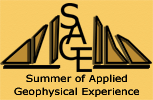|
 |
 |
Introduction to Sage
The Concept
 SAGE, the Summer of Applied Geophysical Experience,is
a unique educational program designed to introduce students
in geophysics and related fields to "hands on" geophysical
exploration and research.
SAGE, the Summer of Applied Geophysical Experience,is
a unique educational program designed to introduce students
in geophysics and related fields to "hands on" geophysical
exploration and research.
The program emphasizes both teaching of field methods and
research related to basic and applied problems.
|
The Overview
Field Environment
 |
 |
 |
The field area in northern New Mexico provides
a stimulating environment to study the structure and tectonics
of the Rio Grande rift as well as smaller-scale environmental
and hydrologic problems. |
|
Co-director, W. Scott Baldridge, describes
outcropping rock relationships. SAGE aims to image the
hidden subsurface by geophysical methods using constraints
imposed by the known geology. |
Industry
Industry affiliates have become an integral part of SAGE providing modern equipment and the latest software. Industry visitors allow students to experience and interact with working geophysicists.
 |
 |
 |
 |
ARCO crew member George Clark explains seismic recording system. |
Hans Rasmussen, Kennecott Mining, discusses the finer points of
transient electromagnetic sounding. |
Peter Annan, President of Sensors and Software, oversees collection of
ground penetrating radar data at environmental site. |
SAGE students setup controlled source audiomagnetotelluric antennas for
system provided by Geometrics Inc. |
Data Processing
SAGE is not just about using equipment; it's about understanding what the equipment is measuring, and how to make sense of it. Students work
in teams to process the field data, model it with computers, and present their findings in written and oral form. This is done with
guidance from SAGE faculty, teaching assistants, and visitors in more of a co-worker environment compared to most university classes.
 |
 |
 |
|
SAGE students process seismic data with guidance from SAGE faculty member Larry Braile and Chevron's Chief Geophysicist Matt Mikalich. |
Geoelectric model of Valles Caldera region obtained using SAGE
magnetotelluric data. |
SAGE students model magnetotelluric data on SPARC workstation donated by Sun
Microsystems. |
| |
|
|
Student oral presentations follow the format of a professional meeting
and are a fitting finale to SAGE. |
SAGE students ponder
over seismic records. |
|
What Students Say
SAGE,
the Summer of Applied Geophysical Experience, is a
unique educational program designed to introduce students
in geophysics and related fields to "hands on" geophysical
exploration and research.
The program emphasizes both teaching of field methods and
research related to basic and applied problems. Here are a
few comments from past SAGE participants.
"SAGE
put me on solid footing for my last two years of (undergraduate)
college." (Rowena Lohman, Caltech, SAGE 1996)
"When
I returned from the exciting summer in New Mexico, I hastened
my search for graduate schools and I am attempting to graduate
a year early so I can move on to research in graduate school."
(Marty Terrell, State University of New York - Fredonia)
"You've
Fourier transformed my life." (Bella Desai, Yale University,
SAGE 1997)
SAGE "is
to budding geophysicists the equivalent of an immersion course
in a foreign language for a diplomat." (Geophysics - The Leading
Edge of Exploration, March, 1991) |
|
 |
 |





